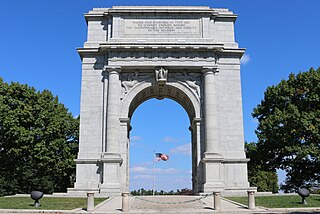
Valley Forge National Historical Park is the site of the third winter encampment of the Continental Army during the American Revolutionary War from December 19, 1777 to June 19, 1778. The National Park Service preserves the site and interprets the history of the Valley Forge encampment. The park contains historical buildings, recreated encampment structures, memorials, museums, and recreation facilities.

Morristown National Historical Park is a United States National Historical Park, headquartered in Morristown, New Jersey, consisting of four sites important during the American Revolutionary War: Jockey Hollow, Ford Mansion, Fort Nonsense, and Washington's Headquarters Museum.
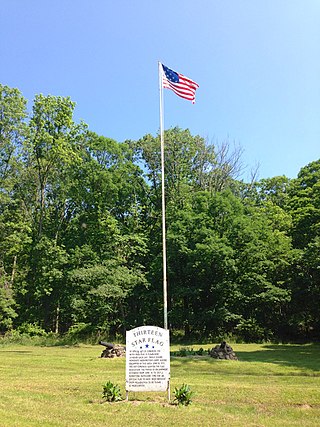
"Middlebrook encampment" may refer to one of two different seasonal stays of the Continental Army in central New Jersey near the Middlebrook in Bridgewater Township in Somerset County. They are usually differentiated by either the date of the encampment or their chronological order.
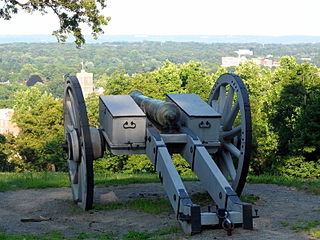
Fort Nonsense is one of four sites comprising the Morristown National Historical Park, in Morristown, Morris County, New Jersey, United States. Two other sites in Morris County are the Ford Mansion and Jockey Hollow. The fourth is the New Jersey Brigade Encampment Site in Bernardsville, Somerset County.
The 3rd New York Regiment was authorized May 25, 1775, and organized from June 28 to August 4 from the counties of Ulster, Dutchess, Orange, and Suffolk under the command of Colonel James Clinton for five months service in Canada. The enlistments of the first establishment ended on December 31, 1775.
The 2nd New Jersey Regiment was raised, on 9 October 1775, at Trenton, New Jersey, for service with the Continental Army under the command of Colonel William Maxwell. The regiment would see action at the Battle of Trois-Rivières, Battle of Valcour Island, Battle of Brandywine, Battle of Germantown, Battle of Crooked Billet, Battle of Monmouth, Sullivan Expedition, Battle of Springfield and the Battle of Yorktown. The regiment was furloughed, on 6 June 1783, at Newburgh, New York, and disbanded 3 November 1783.

The 2nd Pennsylvania Regiment, formed with lauded veterans from the 1st Pennsylvania Battalion, was raised in December 1776.

The Wallace House is a Georgian style historic house, which served as the headquarters of General George Washington during the second Middlebrook encampment (1778–79), located at 38 Washington Place, Somerville, Somerset County, New Jersey, United States. It was added to the National Register of Historic Places on December 2, 1970.

Jockey Hollow is the name for an area in southern Morris County, New Jersey farmed in the 18th century by the Wick, Guerin and Kemble families. The origin of the name is still uncertain, but was used as such at the time of the American Revolution. For most of the Revolutionary War, it was used by portions of Continental Army as a winter camp site, and it housed the main Continental Army during the "Hard Winter" of 1779–80, believed to be the harshest winter in recorded history.

The Ford Mansion, also known as Washington's Headquarters, is a classic 18th-century American home located at 30 Washington Place in Morristown, New Jersey that served as General George Washington's headquarters from December 1779 to June 1780 during the American Revolutionary War.

Valley Forge functioned as the third of eight winter encampments for the Continental Army's main body, commanded by General George Washington, during the American Revolutionary War. In September 1777, Congress fled Philadelphia to escape the British capture of the city. After failing to retake Philadelphia, Washington led his 12,000-man army into winter quarters at Valley Forge, located approximately 18 miles (29 km) northwest of Philadelphia. They remained there for six months, from December 19, 1777 to June 19, 1778. At Valley Forge, the Continental Army struggled to manage a disastrous supply crisis while retraining and reorganizing their units. About 1,700 to 2,000 soldiers died from disease, possibly exacerbated by malnutrition.
The Pluckemin Continental Artillery Cantonment Site in Pluckemin, New Jersey, at the southern section of Bedminster Township, New Jersey, holds historic American Revolutionary War importance as the Continental Army's artillery winter cantonment during the winter of 1778–79. It was nestled on the western side of the Second Watchung Mountain just to the North of the village of Pluckemin. The major significance of the site lies with the very different picture it yields of military organization during the Revolutionary War, although some point to it as the birthplace of the American military academy, 24 years prior to the founding of the United States Military Academy at West Point.

The Patriots' Path is a multi-use trail system in Morris County, New Jersey, open to cyclists, hikers, and horseback riders, consisting of a 55-mile (89 km) main trail and 35 miles (56 km) of spur trails. The main trail is marked with white blazes or a white circular blaze with a brown tree. The spur trails are marked with blue blazes or a white circle with a blue tree, while the side spur trails are marked with a red blaze or a white circle with a red tree.
Temperance Wick, also known as Tempe Wick and Tempe, was an American Revolutionary War heroine and the subject of many early American legends. She is traditionally regarded as an example of female patriotism in the early Republic, though many scholars and historians dispute the historical accuracy of the stories and traditions surrounding her life.

The Staats House, also known as the General Baron von Steuben Headquarters, is a historic building located at 17 Von Steuben Lane in South Bound Brook, Somerset County, New Jersey. Constructed c. 1740, it is now known as the Abraham Staats House after its second owner. In 1779, during the second Middlebrook encampment of the American Revolutionary War, it served as the headquarters for Prussian-American General Friedrich Wilhelm von Steuben. The house was added to the National Register of Historic Places on December 4, 2002, and noted as representing "one of the finest remaining buildings from the second phase of Dutch immigration and settlement in the Raritan Valley".
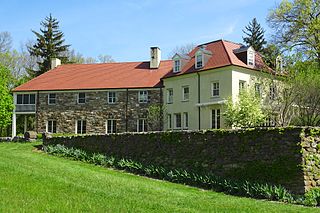
Cross Estate Gardens, containing both formal and native plant gardens, is located at 61 Jockey Hollow Road, Bernardsville, Somerset County, New Jersey. It is on the New Jersey Brigade Encampment Site of the Morristown National Historical Park. The property was acquired in 1975 by the National Park Service.
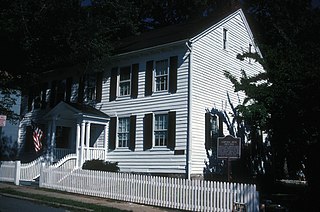
The Dr. Jabez Campfield House, also known as the Schuyler Hamilton House, is a historic, two-story, braced timber-frame colonial Georgian-style house and museum located at 5 Olyphant Place, Morristown, New Jersey.
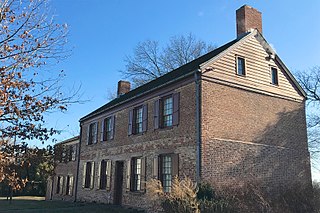
The Van Veghten House is a historic building in the Finderne section of Bridgewater Township, New Jersey. It was built around 1725 and served as the headquarters of Quartermaster General Nathanael Greene during the second Middlebrook encampment (1778–79) in the American Revolutionary War. The Somerset County Historical Society owns the house and uses it as its headquarters, including a museum and library. The early 18th-century Old York Road passed by here connecting Philadelphia to New York City. The house was added to the National Register of Historic Places on October 10, 1979 and noted as representing "one of the few remaining Raritan River mansions".
Dr. Jabez Campfield was a colonial-era doctor, one of the earliest to set up practice in Morristown, New Jersey. He served as a surgeon in the Continental Army during the American Revolutionary War. During the Continental Army's winter encampment in Morristown in 1777, Dr. Campfield helped inoculate soldiers against a smallpox outbreak that spread through the army and the area that winter. Dr. Campfield was a surgeon on the Sullivan Expedition in upstate New York in the summer and autumn of 1779, during which he kept a detailed diary which has been preserved and published. During the winter encampment of 1779-1780, surgeon general Dr. John Cochran stayed in Dr. Campfield's home, and his home served as a "flying hospital". Dr. Cochran's niece, Elizabeth Schuyler, came to stay in Dr. Campfield's home, and while there fell in love and became engaged to Founding Father Alexander Hamilton.

Franklin Corners is an unincorporated community located along the Passaic River at the intersection of County Route 613 and U.S. Route 202 in Bernards Township of Somerset County, New Jersey. In the 19th century, it had a grist mill, saw mill, general store, school, and several houses. The Franklin Corners Historic District, featuring Van Dorn's Mill, was listed on the National Register of Historic Places in 1975.






















